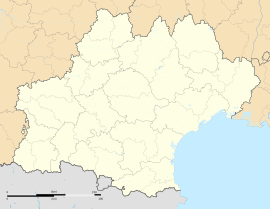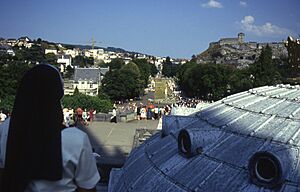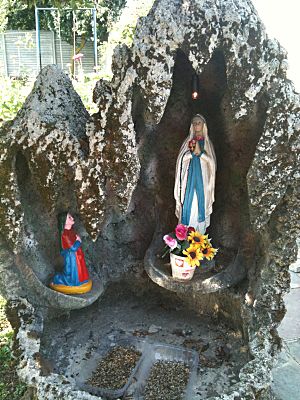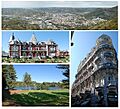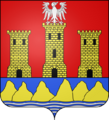Lourdes facts for kids
Quick facts for kids
Lourdes
Lorda (Occitan)
|
||
|---|---|---|
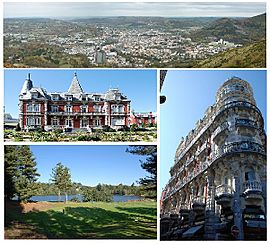
Lourdes with the Sanctuary of Our Lady
|
||
|
||
| Country | France | |
| Region | Occitanie | |
| Department | Hautes-Pyrénées | |
| Arrondissement | Argelès-Gazost | |
| Canton | Lourdes-1 and 2 | |
| Intercommunality | CA Tarbes-Lourdes-Pyrénées | |
| Area
1
|
36.94 km2 (14.26 sq mi) | |
| Population
(2021)
|
13,509 | |
| • Density | 365.70/km2 (947.16/sq mi) | |
| Demonym(s) | Lourdais | |
| Time zone | UTC+01:00 (CET) | |
| • Summer (DST) | UTC+02:00 (CEST) | |
| INSEE/Postal code |
65286 /65100
|
|
| Elevation | 343–960 m (1,125–3,150 ft) | |
| 1 French Land Register data, which excludes lakes, ponds, glaciers > 1 km2 (0.386 sq mi or 247 acres) and river estuaries. | ||
Lourdes is a famous town located in the Pyrenees mountains in southwestern France. It is part of the Hautes-Pyrénées area in the Occitanie region. For a long time, Lourdes was mainly known for its strong castle. This old castle sits high up on a rocky hill in the middle of the town.
In 1858, Lourdes became very famous in France and around the world. This happened because a young girl named Bernadette Soubirous said she saw the Virgin Mary appear to her. After these events, Lourdes and its Sanctuary of Our Lady of Lourdes became one of the most important places for pilgrimage (religious journeys) and religious tourism in the world.
Contents
History of Lourdes
Ancient Times
People have lived in the area of Lourdes since prehistoric times. During Roman times, starting around the first century BC, there was a fortified hilltop town called an oppidum where the castle is now. We know this from many old items found when the Saint Pierre church was taken down.
Archaeologists found parts of old walls, pieces of a fortress, and a temple for water gods. They also found three altars. In the fifth century, a Christian church was built where the temple was, but it later burned down. A Roman road nearby suggests Lourdes might have been an important stop connecting the Pyrenees with Narbonne.
From 732 to 778, Lourdes was controlled by Muslims from Al-Andalus. A Muslim leader named Mirat was under attack by Charlemagne, the King of the Franks. Mirat refused to give up. A legend says an eagle dropped a large fish at Mirat's feet. Seeing this as a bad sign, Mirat was told by a local bishop to surrender to the "Queen of the Sky." He visited a statue of the Black Virgin of Puy and was so amazed that he decided to give up the fort and become a Christian. He was baptized as Lorus, and the town was named Lourdes after him.
Middle Ages
Not much is known about Lourdes from the time of the barbarian invasions until the Carolingian period. During this time, Lourdes was part of the County of Bigorre. The fortress was sometimes used by counts.
During the Albigensian Crusade, different local lords fought over the castle. Eventually, it came under the control of the Counts of Champagne. In the 1300s, Lourdes was first taken by Philip the Fair. Then, during the Hundred Years' War, the English controlled it for almost 50 years, from 1360 to 1407.
The English used the castle's great location and the town's busy market to their advantage. The market had grown strong since the 1000s because it was close to Toulouse and Spain. In 1405, Charles VI of France attacked the castle. After an 18-month siege, the French finally captured the town from the English.
Modern Age
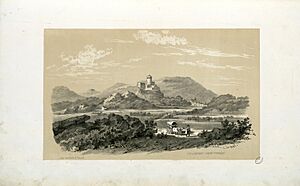
In the late 1500s, France had many religious wars between Catholics and Protestants (called Huguenots). In 1569, Count Gabriel de Montgomery attacked nearby Tarbes after Queen Jeanne d'Albret of Navarre made it a Protestant town. In 1592, Catholic forces took Lourdes, and the Catholic faith was brought back. In 1607, Lourdes officially became part of the Kingdom of France.
The castle became a prison under Louis XV. But in 1789, a group called the Estates General ordered prisoners to be freed. When Napoleon came to power in 1803, he made the castle a state prison again. Towards the end of the Peninsular War in 1814, British and allied forces led by the Duke of Wellington entered France. They defeated the French army near Tarbes, and the war ended after a final battle near Toulouse.
Until 1858, Lourdes was a quiet country town with about 4,000 people. It had a small army group in the castle. It was also a stopping point for people going to nearby spa towns and for mountain climbers.
Then, on February 11, 1858, a 14-year-old local girl named Bernadette Soubirous said a beautiful lady appeared to her in a cave called Massabielle. The lady later said she was the "Immaculate Conception" and believers thought she was the Blessed Virgin Mary. She appeared 18 times, and by 1859, thousands of pilgrims were visiting Lourdes. A statue of Our Lady of Lourdes was put up at the site in 1864.
During World War II, fewer people made pilgrimages to Lourdes. However, Lourdes became a place for religious resistance against the war. Refugees from Lorraine visited in 1941. In 1944, a peace pilgrimage took place in Lourdes. After the war, it took some time for pilgrimages to return to normal levels.
Since the apparitions, Lourdes has become one of the world's most important Catholic Marian shrines. Pope John Paul II visited twice, in 1983 and 2004. In 2007, Pope Benedict XVI allowed special blessings to mark 150 years since the first apparition.
Geography of Lourdes
Lourdes is in southern France, at the foot of the Pyrenees mountains. It is near the prime meridian. To the south, you can see the high Pyrenean peaks like Aneto and Vignemale, which is about 3,298 meters (10,820 feet) tall. Around the town, there are three peaks up to 1,000 meters (3,281 feet) high. These are called the Béout, the Petit Jer, and the Grand Jer.
You can reach the Grand Jer using a funicular railway. The Béout used to have a cable car, but it is no longer working. Lourdes is about 420 meters (1,378 feet) above sea level. The fast-flowing river Gave de Pau runs through the town from the south. This river starts at Gavarnie and is joined by smaller rivers from Barèges and Cauterets. The Gave then flows west past the Grotto and on to Pau and Biarritz.
There is a rock outcrop called Massabielle (meaning "old mass") near a bend in the Gave de Pau river. On the north side of this rock, close to the river, is a natural cave or grotto. This is where the apparitions of 1858 happened.
Climate
Lourdes has an oceanic climate because it is close to the Atlantic Ocean. The weather is usually mild for most of the year. It has moderate rainfall in summer and quite a lot of rain in winter. There are about 120 rainy days and over 1,000 mm (39 inches) of rain each year. Summers are warm, autumn and spring are mild, and winter is cool.
Because Lourdes is near the Pyrenees, it can sometimes get very cold in winter. In January 1985, the temperature dropped to -27°C (-17°F). The hottest summer temperature recorded was 39°C (102°F) in August 2003. The weather station for Lourdes is near the Tarbes-Lourdes-Pyrénées airport, about 9 km (5.6 miles) from town.
| Stat. of Tarbes (1982–2013) | Jan | Feb | Mar | Apr | May | Jun | Jul | Aug | Sep | Oct | Nov | Dec | Year |
|---|---|---|---|---|---|---|---|---|---|---|---|---|---|
| Tp. min. avg (°C) | 1,0 | 1,5 | 3,6 | 5,7 | 9,6 | 12,9 | 15,0 | 15,0 | 12,0 | 8,7 | 4,4 | 1,8 | 7,7 |
| Tp. avg (°C) | 5,7 | 6,4 | 8,9 | 10,8 | 14,6 | 17,9 | 20,1 | 20,2 | 17,5 | 14,0 | 9,1 | 6,5 | 12,7 |
| Tp. max. avg (°C) | 10,3 | 11,2 | 14,2 | 15,9 | 19,6 | 22,8 | 25,2 | 25,3 | 22,9 | 19,2 | 13,7 | 11,1 | 17,7 |
| Frost days | 10,88 | 9,69 | 4,78 | 1,06 | 0 | 0 | 0 | 0 | 0 | 0,31 | 4,1 | 9,74 | 40,34 |
| Precipitation (mm) | 95.3 | 83.0 | 85.3 | 110.7 | 114.2 | 78.4 | 57.7 | 66.0 | 72.3 | 84.3 | 103.5 | 92.0 | 1041.8 |
| Rainy days | 10,59 | 9,5 | 10,16 | 12,53 | 12,91 | 9,75 | 7,19 | 8,47 | 8,53 | 10,28 | 10,16 | 10,29 | 120,35 |
| Climate data for Lourdes (1981−2010 normals, extremes 1881−2011) | |||||||||||||
|---|---|---|---|---|---|---|---|---|---|---|---|---|---|
| Month | Jan | Feb | Mar | Apr | May | Jun | Jul | Aug | Sep | Oct | Nov | Dec | Year |
| Record high °C (°F) | 24.7 (76.5) |
27.0 (80.6) |
30.0 (86.0) |
32.0 (89.6) |
34.6 (94.3) |
41.0 (105.8) |
39.9 (103.8) |
40.5 (104.9) |
37.0 (98.6) |
34.0 (93.2) |
28.0 (82.4) |
26.0 (78.8) |
41.0 (105.8) |
| Mean daily maximum °C (°F) | 11.0 (51.8) |
12.3 (54.1) |
15.4 (59.7) |
17.1 (62.8) |
20.7 (69.3) |
23.8 (74.8) |
26.1 (79.0) |
26.3 (79.3) |
23.7 (74.7) |
19.8 (67.6) |
14.4 (57.9) |
11.6 (52.9) |
18.5 (65.3) |
| Daily mean °C (°F) | 6.3 (43.3) |
7.3 (45.1) |
10.0 (50.0) |
11.7 (53.1) |
15.3 (59.5) |
18.4 (65.1) |
20.6 (69.1) |
20.7 (69.3) |
18.0 (64.4) |
14.6 (58.3) |
9.6 (49.3) |
7.0 (44.6) |
13.3 (55.9) |
| Mean daily minimum °C (°F) | 1.5 (34.7) |
2.3 (36.1) |
4.5 (40.1) |
6.3 (43.3) |
9.9 (49.8) |
13.1 (55.6) |
15.1 (59.2) |
15.2 (59.4) |
12.4 (54.3) |
9.4 (48.9) |
4.8 (40.6) |
2.3 (36.1) |
8.1 (46.6) |
| Record low °C (°F) | −18.2 (−0.8) |
−16.5 (2.3) |
−12.0 (10.4) |
−4.9 (23.2) |
−3.8 (25.2) |
1.0 (33.8) |
0.5 (32.9) |
1.5 (34.7) |
−0.1 (31.8) |
−4.0 (24.8) |
−9.9 (14.2) |
−17.0 (1.4) |
−18.2 (−0.8) |
| Average precipitation mm (inches) | 135.1 (5.32) |
109.5 (4.31) |
120.7 (4.75) |
149.9 (5.90) |
139.6 (5.50) |
103.9 (4.09) |
82.5 (3.25) |
87.1 (3.43) |
94.9 (3.74) |
121.9 (4.80) |
145.5 (5.73) |
136.1 (5.36) |
1,426.7 (56.17) |
| Average precipitation days (≥ 1.0 mm) | 12.4 | 11.6 | 12.0 | 14.3 | 15.0 | 11.9 | 10.8 | 10.7 | 10.3 | 12.3 | 12.4 | 12.2 | 146.1 |
| Source: Météo-France | |||||||||||||
Apparitions and Pilgrimages
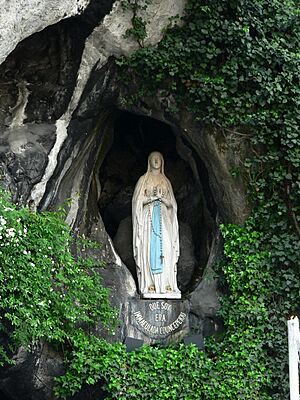
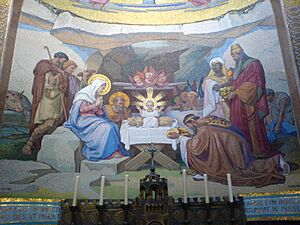
In 1858, a young Catholic girl named Bernadette Soubirous said the Virgin Mary appeared to her 18 times in Lourdes. Because of these events, Lourdes has become a very important place for Roman Catholic pilgrimages. Many people believe that miraculous healings happen there.
In 2008, Lourdes celebrated 150 years since the first apparition. About 45,000 pilgrims attended an outdoor Mass. In 2020, Lourdes had about 15,000 people living there. In 2012, 715,000 pilgrims visited for events related to Our Lady of Lourdes. By 2011, Lourdes had about 270 hotels, which is the second-highest number of hotels per square kilometer in France, after Paris.
Marian Apparitions: The Story of Bernadette
On the evening of February 11, 1858, Bernadette Soubirous, a young Catholic girl, went to collect firewood. She reported that a very beautiful lady appeared to her in the Massabielle grotto. The lady did not say her name at first but asked Bernadette to return to the grotto.
On later visits, the lady told Bernadette she was the "Immaculate Conception." This was a special teaching of the Catholic Church, made just four years earlier, that the Virgin Mary was born without original sin. Bernadette, who didn't know much about Catholic teachings, didn't understand this. But she told her priest, Father Peyremale. The priest, who was at first doubtful, became convinced because he knew Bernadette couldn't have known about this teaching on her own.
The lady also told Bernadette to dig in the ground at a certain spot and drink from a small spring that started to flow. Soon after, people reported being healed by the water. Today, thousands of gallons of water flow from this spring, and pilgrims can bathe in it. Many amazing cures have been reported, from nerve problems and cancers to paralysis and even blindness. During the apparitions, Bernadette Soubirous prayed the Rosary. Pope John Paul II said the Rosary is a very important prayer that helps people become more holy.
Messages from the Apparitions
Here are some of the things Our Lady said to Saint Bernadette:
- February 18, 1858 (Ash Wednesday): "It is not necessary [to write down my name]. Would you be kind enough to come here for 15 days? I do not promise to make you happy in this world, but in the next."
- February 21, 1858: (In a sad voice) "Pray for sinners."
- February 24, 1858: "Penance! Penance! Penance! Pray to God for sinners."
- February 25, 1858: "Go, drink of the spring and wash yourself there. You will eat the grass that is there."
- February 27, 1858: "Penance! Penance! Penance! Pray to God for sinners. Go, kiss the ground for the conversion of sinners. Go and tell the priests to have a chapel built here."
- February 28, 1858: "Penance! Penance! Penance! Pray to God for sinners. Go, kiss the ground for the conversion of sinners."
- March 2, 1858: "Go, tell the priests to bring people here in procession and have a Chapel built here."
- March 25, 1858: "I am the Immaculate Conception."
Religious Sites
Sanctuary of Lourdes
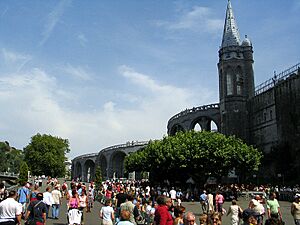
Every year from March to October, the Sanctuary of Our Lady of Lourdes is a major place for pilgrimages from Europe and other parts of the world. Many Catholics believe that the spring water from the grotto has healing powers.
It is estimated that 200 million people have visited the shrine since 1860. The Roman Catholic Church has officially recognized 69 healings as miraculous. These cures are checked carefully to make sure they are real miracles and not just from physical or mental reasons.
Many tours from all over the world are organized to visit the Sanctuary. A common part of these trips is drinking or bathing in the Lourdes water that flows from the Grotto. When the apparitions happened, the grotto was on common land used by villagers for animals and firewood. It was known as an unpleasant place.
Ukrainian Church
Lourdes also has a beautiful five-domed St. Mary's Ukrainian Catholic Church. It was designed by Myroslav Nimciv. The inside decorations were done by artist Jerzy Nowosielski, and the iconostasis (a screen with icons) was made by Petro Kholodny. The church was opened in 1982. It is about a 10-minute walk from the main basilica and grotto, on a street named 8 Rue de l'Ukraine. Even though it's on a narrow piece of land, its height makes it stand out and it can be seen from the basilica.
Population of Lourdes
| Historical population | ||
|---|---|---|
| Year | Pop. | ±% p.a. |
| 1968 | 17,939 | — |
| 1975 | 17,870 | −0.06% |
| 1982 | 17,425 | −0.36% |
| 1990 | 16,300 | −0.83% |
| 1999 | 15,203 | −0.77% |
| 2007 | 15,254 | +0.04% |
| 2012 | 14,466 | −1.06% |
| 2017 | 13,389 | −1.54% |
| Source: INSEE | ||
International Connections
Lourdes is twinned with several cities around the world. This means they have special friendly relationships. Here are some of them:
 Basilica of Our Lady of Good Health in Vailankanni, India
Basilica of Our Lady of Good Health in Vailankanni, India Częstochowa in Poland
Częstochowa in Poland Fátima in Portugal
Fátima in Portugal Loreto in Italy
Loreto in Italy Altötting in Germany
Altötting in Germany Cheyenne in Wyoming, United States
Cheyenne in Wyoming, United States Mariazell in Austria
Mariazell in Austria
Sports in Lourdes
Even though Lourdes is most famous for its religious sites, it's also known for its Rugby union team, FC Lourdes. This team was one of the best in France in the mid-1900s. They won the national championship eight times between 1948 and 1968. Their most famous player was Jean Prat, who played for his country 51 times.
There is also an amateur soccer team in the town. Since 2015, the local mountain biking course has hosted a UCI Downhill World Cup race every season.
Lourdes in Arts and Stories
- Émile Zola (1840–1902) wrote a novel called Lourdes in 1884. It explores themes of faith and healing.
- The 1943 film Song of Bernadette tells the story of what happened in Lourdes. It was based on a 1941 novel by Franz Werfel and won four Academy Awards in 1944.
- In 1960, Andy Williams released an album called The Village of St. Bernadette, which included the popular song of the same name.
- The 1963 film Behold a Pale Horse, directed by Fred Zinnemann, has an important scene in Lourdes. This scene was filmed in the actual town and shows real pilgrims.
- The 1984 book The Miracle by Irving Wallace is a fictional story based on the life of Saint Bernadette.
- The 2007 film The Diving Bell and the Butterfly includes a flashback where the main character visits Lourdes.
- The 2019 documentary film Lourdes shows a close look at different people and families on their journey to Lourdes.
- The 2023 film The Miracle Club is about a pilgrimage from Dublin, Ireland, to Lourdes.
Getting to Lourdes
Lourdes is served by Tarbes-Lourdes-Pyrénées Airport, which is about 10 km (6 miles) from the town center. Many visitors also fly to Pau Pyrénées Airport. The town's railway station, Gare de Lourdes, has trains from SNCF and TGV (high-speed trains). A TGV train from Paris takes about four and a half hours. Many pilgrims also arrive by bus from France and Spain.
Education in Lourdes
Lourdes has two main schools: one public and one private. The private school, "Lycée Peyramale St Joseph," was started by two monks just two years before the apparitions. It is named after Father Dominique Peyramale, who was present during the apparitions. This school celebrated its 150th anniversary in 2007. The newer public school is called the "Lycée de Sarsan."
Museums to Visit
- Wax Museum
- Pyrenean Museum
- Museum of the Nativity
- Museum of small Lourdes
Images for kids
See also
 In Spanish: Lourdes (Altos Pirineos) para niños
In Spanish: Lourdes (Altos Pirineos) para niños




